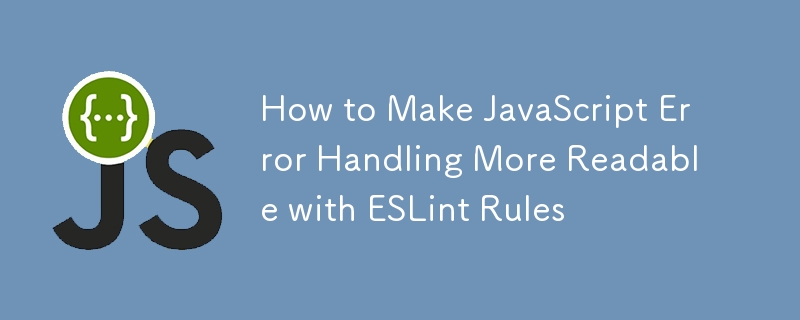

Pengendalian ralat yang berkesan adalah penting untuk mana-mana aplikasi JavaScript yang mantap. Ia membantu dalam pengenalan isu pantas, memudahkan penyahpepijatan dan meningkatkan kebolehpercayaan perisian. Panduan ini menyelidiki dalam meningkatkan pengendalian ralat JavaScript melalui ESLint, alat yang menguatkuasakan kualiti kod dan menyeragamkan amalan pengendalian ralat.
Pengendalian ralat boleh dibaca memberikan cerapan segera tentang isu, membantu pembangun memahami dan menyelesaikan masalah dengan cekap. Amalan ini penting dalam persekitaran pasukan dan penting untuk mengekalkan kod dalam jangka panjang.
Untuk meningkatkan pengendalian ralat JavaScript anda, pertimbangkan strategi berikut:
try {
const data = JSON.parse(response);
console.log(data);
} catch (error) {
console.error("Failed to parse response:", error);
}
class ValidationError extends Error {
constructor(message) {
super(message);
this.name = "ValidationError";
}
}
try {
throw new ValidationError("Invalid email address");
} catch (error) {
console.error(error.name, error.message);
}
function handleError(error) {
console.error(`${new Date().toISOString()} - Error: ${error.message}`);
}
Versi melontar:
function calculateAge(dob) {
if (!dob) throw new Error("Date of birth is required");
}
Versi tanpa melontar:
function tryCalculateAge(dob) {
if (!dob) {
console.error("Date of birth is required");
return null;
}
}
Menyediakan ESLint untuk menguatkuasakan amalan ini melibatkan langkah dan konfigurasi berikut:
npm install eslint --save-dev npx eslint --init
Pengendalian ralat yang berkesan adalah penting untuk membangunkan aplikasi JavaScript yang mantap. Di bawah ialah peraturan ESLint yang boleh membantu menguatkuasakan amalan pengendalian ralat yang baik dalam pangkalan kod anda.
"promise/no-return-in-finally": "warn", "promise/always-return": "error"
"no-await-in-loop": "error"
// Incorrect
async function processArray(array) {
for (let item of array) {
await processItem(item);
}
}
// Correct
async function processArray(array) {
const promises = array.map(item => processItem(item));
await Promise.all(promises);
}
"promise/catch-or-return": "error", "async-await/space-after-async": "error"
"consistent-return": "error"
"no-unused-vars": ["error", {"args": "none"}],
"no-unused-catch-bindings": "error"
"no-throw-literal": "error"
// Incorrect
throw 'error';
// Correct
throw new Error('An error occurred');
"max-nested-callbacks": ["warn", 3]
"no-unused-expressions": ["error", {"allowShortCircuit": true, "allowTernary": true}]
"node/handle-callback-err": "error"
"no-console": "warn"
Ensure ESLint runs automatically before code commits or during CI/CD processes.
By adopting these ESLint rules and error-handling strategies, you elevate the readability and reliability of your JavaScript applications. These improvements facilitate debugging and ensure a smoother user experience.
Are you ready to transform your error handling approach? Implement these practices in your projects to see a significant boost in your development efficiency and code quality. Embrace these enhancements and lead your projects to success.
Das obige ist der detaillierte Inhalt vonSo machen Sie die JavaScript-Fehlerbehandlung mit ESLint-Regeln lesbarer. Für weitere Informationen folgen Sie bitte anderen verwandten Artikeln auf der PHP chinesischen Website!




